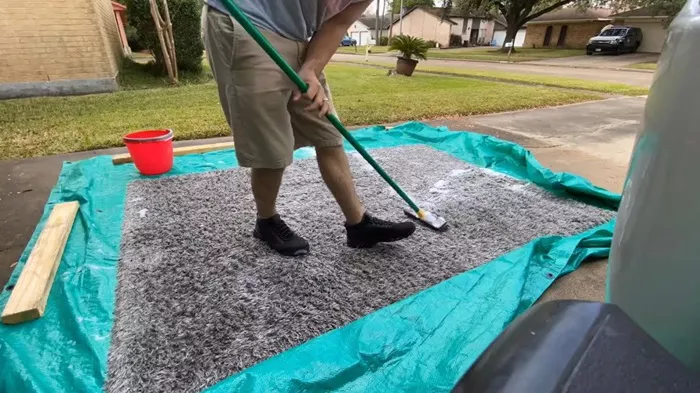Cleaning a rug can be a daunting task, especially when it’s large and heavily soiled. Traditional methods might not always yield the best results, and that’s where power washing comes in. Power washing a rug can be an effective way to remove deep-seated dirt and stains, restoring it to its original beauty. This article will guide you through the entire process of power washing a rug, ensuring you achieve professional-level results.
See Also: 5 best robot vacuum cleaners to mop floors and get rid of dust and pet hair
Introduction to Power Washing Rugs
Power washing, also known as pressure washing, uses a high-pressure water spray to remove dirt, grime, mold, and other contaminants from surfaces. While it’s commonly used for exterior surfaces like decks, driveways, and buildings, power washing can also be used for rugs. The key is to use the right techniques and equipment to avoid damaging the rug’s fibers.
Why Choose Power Washing?
- Efficiency: Power washing is much faster than traditional scrubbing.
- Effectiveness: The high-pressure water can penetrate deep into the rug fibers.
- Versatility: Suitable for various types of rugs, from synthetic to natural fibers.
- Eco-Friendly: Uses water and minimal cleaning agents, reducing chemical use.
Types of Rugs Suitable for Power Washing
Not all rugs are suitable for power washing. Here are some types that generally fare well:
- Synthetic Rugs: Made from materials like nylon, polyester, and polypropylene.
- Outdoor Rugs: Designed to withstand the elements, making them ideal for power washing.
- Sturdy Natural Fiber Rugs: Such as wool and jute, but with caution.
Avoid power washing delicate rugs, such as silk or antique pieces, as the high pressure can damage them.
Equipment and Materials Needed
Before you start, gather the necessary equipment and materials:
- Power Washer: Preferably with adjustable pressure settings.
- Water Source: A garden hose connected to the power washer.
- Mild Detergent: Specifically designed for rugs or general-purpose cleaners.
- Stiff-Bristled Brush: For pre-treating stains.
- Protective Gear: Gloves, goggles, and waterproof boots.
- Clean Water: For rinsing.
- Drying Area: Preferably an elevated, well-ventilated space.
Step-by-Step Guide to Power Washing a Rug
Step 1: Prepare the Rug
Before you start power washing, prepare the rug to ensure the best results:
- Vacuum the Rug: Remove loose dirt and debris. Vacuum both sides of the rug.
- Check for Damage: Inspect the rug for any tears or weak spots. Repair if necessary.
- Pre-Treat Stains: Use a mild detergent and a stiff-bristled brush to scrub any visible stains.
Step 2: Set Up the Power Washer
- Connect the Power Washer: Attach the power washer to a water source. Ensure all connections are secure.
- Choose the Right Nozzle: Use a nozzle with a wide spray pattern (25-40 degrees) to avoid damaging the rug.
- Adjust the Pressure: Start with a low pressure (1200-1500 PSI). You can increase if needed, but avoid going too high.
Step 3: Test the Power Washer
Before washing the entire rug, test a small inconspicuous area:
- Spray the Test Area: Hold the nozzle about 2-3 feet from the rug.
- Check for Damage: Ensure the fibers are not fraying or the color is not fading.
Step 4: Power Wash the Rug
- Lay the Rug Flat: Place the rug on a flat surface, preferably outdoors on a clean area.
- Start Washing: Hold the nozzle about 2-3 feet from the rug. Move in a sweeping motion.
- Wash in Sections: Divide the rug into sections. This ensures even cleaning.
- Rinse Thoroughly: After washing, rinse the rug with clean water to remove any detergent residue.
Step 5: Dry the Rug
Proper drying is crucial to prevent mold and mildew:
- Squeeze Out Excess Water: Use a squeegee or your hands to remove as much water as possible.
- Hang the Rug: Hang the rug on a clothesline or over a railing. Ensure it’s in a well-ventilated area.
- Check for Dryness: Allow the rug to dry completely. This can take several hours to a couple of days depending on the weather.
Maintenance Tips for Power Washed Rugs
- Regular Vacuuming: Keep the rug clean by vacuuming regularly.
- Spot Cleaning: Address spills and stains immediately.
- Routine Power Washing: Depending on use, power wash the rug once or twice a year.
Common Mistakes to Avoid
- Using Too High Pressure: Can damage the rug fibers.
- Not Rinsing Properly: Leaving detergent residue can attract dirt.
- Inadequate Drying: Can lead to mold and mildew growth.
Conclusion
Power washing a rug is an efficient and effective way to deep clean it, removing dirt and grime that traditional methods might leave behind. By following the steps outlined in this guide, you can ensure your rug is cleaned thoroughly without causing damage. Regular maintenance and proper care will keep your rug looking fresh and new for years to come.
Whether you have a synthetic outdoor rug or a sturdy natural fiber rug, power washing can be a game-changer in your cleaning routine. Equip yourself with the right tools, follow the correct procedures, and you’ll be amazed at the transformation in your rug’s appearance.

